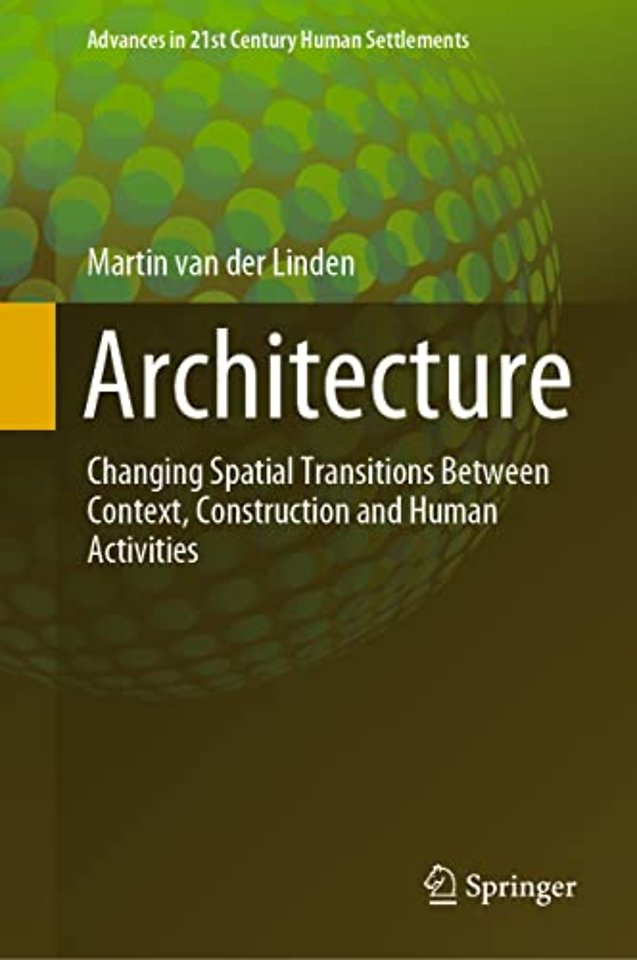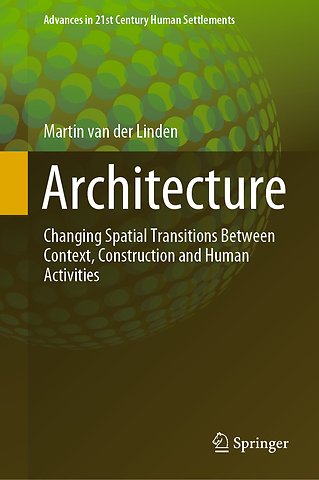Architecture
Changing Spatial Transitions Between Context, Construction and Human Activities
Gebonden Engels 2021 9789813346574Samenvatting
The question of what architecture is answered in this book with one sentence: Architecture is space created for human activities. The basic need to find food and water places these activities within a larger spatial field. Humans have learned and found ways to adjust to the various contextual difficulties that they faced as they roamed the earth. Thus rather than adapting, humans have always tried to change the context to their activities. Humanity has looked at the context not merely as a limitation, but rather as a spatial situation filled with opportunities that allows, through intellectual interaction, to change these limitations. Thus humanity has created within the world their own contextual bubble that firmly stands against the larger context it is set in. The key notion of the book is that architecture is space carved out of and against the context and that this process is deterministic.
Specificaties
Lezersrecensies
Inhoudsopgave
<p>1.2 the jungle: from 2D of the desert into 3D. The limiting contextual parameters, Maslow’s pyramid. </p>
<p>1.3 The human dream of creating our own world. </p>
</div><div><br></div><div>Space for human activity<br> <p>2.1 Spaces of human excess, the history of using materials from outside of the context as a form of luxury.</p>
2.2 Heidegger’s hut, space taken from and build out of the immediate context<br><br></div><div>Is there a grand narrative?<br> <p>3.1 The patterns in nature</p>
<p>3.2 Self implied rules (Greek, Egyptians, Le Corbusier’s eyes that don’t see)</p>
3.3 Boullee’s mental image of space<br><br></div><div>The Limit<br> <p>4.1 Fire (extending context)</p>
4.2 Fear (of the unknown, the space where imagination takes over)<p></p>
<p>4.3 Demarcations (boundaries)</p>
4.4 Death (the ultimate limit of life, and how to overcome this limitation architecturally)<br></div><div><br></div><div>It all started with a fire<br>5.1 Setting the scene: Chicago 5.2 Character one: The Engineer<p></p>
<p>5.3 Character two: The Inventor</p>
<p>5.4 Character three: The Architect</p>
5.5 Character four: The Father of Cool<br><br></div><div>Architectural world domination<br> <p>6.1 Bauhaus - Teach them how to fish</p>
<p>6.2 Weissenhofsiedling - Practical experience</p>6.3 CIAM Congrès internationaux d'architecture modern – Intellectual formulation of the idea of modern architecture <p>6.4 Exhibition at Museum of Modern Art, new York, A first taste of the American dream</p>
6.5 Bye-bye Hitler, hello America!<br><br></div><div>Me, I build this world<br>7.1 Build anything, anywhere. Remove the context from the architectural equation<br>7.2 Out of the crowd, a lonely individual: Kafka & Co 7.3 The strange dialectical dance (example the movies of Jacques Tati)</div><div><br></div><div>Transitional space<br> <p>8.1 Definition</p>
<p>8.2 Example: the deep transitional spaces of Seven, the human adaption machine of Woody Allen in Zelig</p>
8.3 The nowhere is sending messages</div><div><br></div><div>Context welcome<br>9.1 Glass House Johnson <br>9.2 Privacy, openness</div><div><br></div><div>The House as a Container for the Unconscious<br> <p>10.1 Japanese architecture, zenenkons, (The history of an architect in Japan, from hands to minds)</p>
10.2 Shinohara, the anti-metabolist <p></p>
<p>10.3 Shinohara projects</p>
<p>10.4 Both-and Japaneseness</p>
<p>10.5 The house as a work of art, universe in itself</p>
10.6 The world’s most famous unknown architect: Influence of Shinohara on architecture<br></div><div><br></div><div>Conclusion: The future is not what it used to be</div><div><br></div><div>Architectural Scenarios<br> <p>12.1 A re-introduction of the context back into architectural spaces, as a deliberately limiting element to appreciate geographical and/or climate conditions </p>
<p>12.2 The zero-time space. KHMER ROUGE, Superstudio, Archizoom, tracing transitional space to an extreme. </p>
12.3 Is there a dialectic?<br></div>
Rubrieken
- advisering
- algemeen management
- coaching en trainen
- communicatie en media
- economie
- financieel management
- inkoop en logistiek
- internet en social media
- it-management / ict
- juridisch
- leiderschap
- marketing
- mens en maatschappij
- non-profit
- ondernemen
- organisatiekunde
- personal finance
- personeelsmanagement
- persoonlijke effectiviteit
- projectmanagement
- psychologie
- reclame en verkoop
- strategisch management
- verandermanagement
- werk en loopbaan

